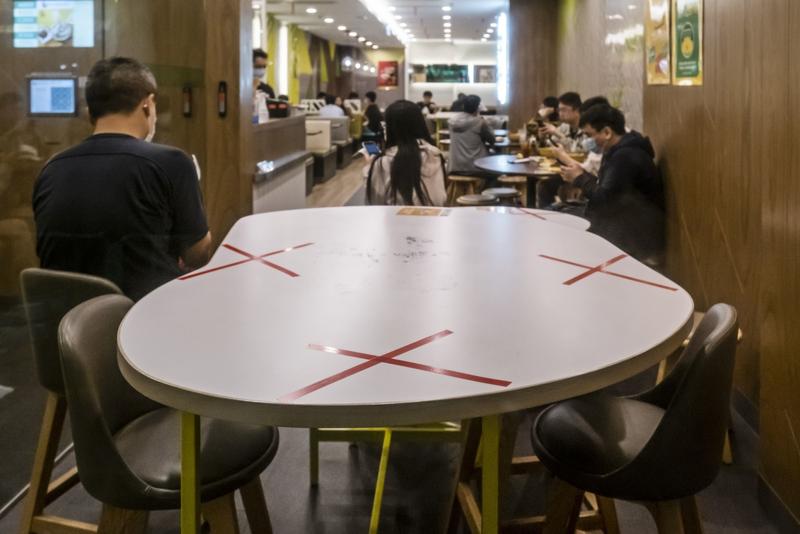 Markings indicate seats are unavailable at a restaurant in Hong Kong on March 28. (JUSTIN CHIN/BLOOMBERG)
Markings indicate seats are unavailable at a restaurant in Hong Kong on March 28. (JUSTIN CHIN/BLOOMBERG)
In the early stages of the coronavirus pandemic, Singapore and Hong Kong saw similar success with dramatically different approaches. Now, Singapore may be paying the price for a strategy that sought to minimize disruption.
After taking a more measured virus-control approach for months, Singapore resorted to some of Hong Kong’s drastic early moves, including school closures and encouraging mask-wearing for all
While Hong Kong has recently seen its case tally slow to a couple dozen a day, Singapore’s has surged 180 percent in the past two weeks with infections popping up in places from pre-schools to migrant worker dormitories. The city-state disclosed a record 287 cases on Thursday, bringing the total to 1,910, more than double Hong Kong’s count.
READ MORE: HK to limit public gatherings to 4, shut establishments
After taking a more measured virus-control approach for months, Singapore resorted to some of Hong Kong’s drastic early moves, including school closures and encouraging mask-wearing for all. Now it’s gone even further, banning all social gatherings and closing all businesses except essential services.
It amounts to an abrupt reversal of fortunes for Asia’s premier financial centers, which have long competed for workers and capital. Weakened by months of protests and a recession, Hong Kong’s government initially came under fire for inconsistent messaging in tackling the virus challenge.
But Hong Kong’s tough early measures to control the virus, colored by its experience 17 years ago with severe acute respiratory syndrome known as SARS, are paying off.
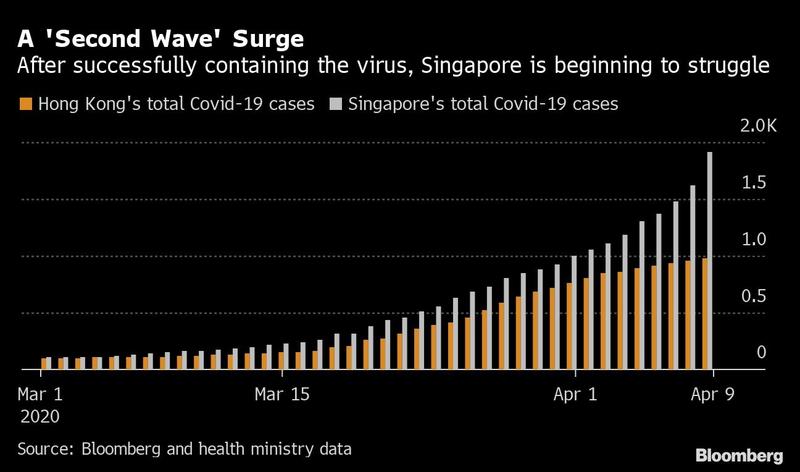
“Hong Kong chose in the very beginning to move toward maximizing protection, but Singapore seemed to be more cautious and focused on minimizing disruption to the economy and society,” said Yanzhong Huang, a professor and director of the Center for Global Health Studies at New Jersey’s Seton Hall University.
Social distancing
“The second wave of resurgent cases in Singapore has highlighted the differences between the two in terms of their approaches to the outbreak -- and even the slightest difference in approach could matter in explaining the different outcomes,” he said.
Singapore’s government has defended its approach. Lawrence Wong, minister for national development who co-chairs a task force to fight the virus, said at a briefing last week that its policies were a “judgment call” and that residents can become fatigued if social distancing is implemented for too long.
The diverging outcomes in Hong Kong and Singapore show how early and strict social distancing measures may be more beneficial to the economy over the long term
“If we had put in place all the measures that we’re talking about now much earlier, we may very well still be in the same situation today,” he said.
The diverging outcomes in Hong Kong and Singapore -- which are still handling the virus far better than many other advanced economies -- show how early and strict social distancing measures may be more beneficial to the economy over the long term. In Europe and the US, politicians are now mulling lifting lockdowns to revive their economies, even as health experts caution against relaxing too soon.
ALSO READ: Singapore says it was 'correct' not to close schools earlier
Hong Kong and Singapore are both wealthy jurisdictions with sophisticated health-care systems and longstanding experience dealing with infectious diseases. In the current crisis, the two cities successfully met a first wave of infections through a mix of flight and travel restrictions and generous testing protocols, as well as the strict contact tracing and quarantining of infected citizens.

The key difference was Hong Kong’s social-distancing measures implemented in late January and early February, which included closing schools and government offices -- a move that pressured many private sector companies to similarly work from home.
The early panic that enveloped the city’s population, already on edge from months of anti-government protests stemming from the extradition bill incident, went viral in pictures of empty supermarket shelves and supply-hoarding, most notably of toilet paper. Residents scarred by SARS largely chose to wear masks in public spaces.
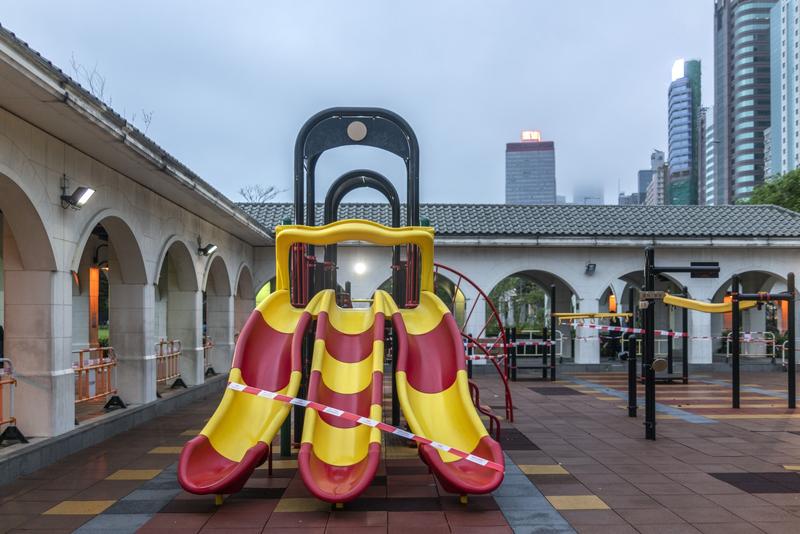 Barrier tape is wrapped around slides to enforce social distancing measures in Hong Kong. (BLOOMBERG)
Barrier tape is wrapped around slides to enforce social distancing measures in Hong Kong. (BLOOMBERG)
Singapore took a different approach, leaving schools and government offices open. Prime Minister Lee Hsien Loong advised that healthy people don’t need to wear masks, in part because it could give a false sense of security while precautions such as washing hands regularly are more effective.
ALSO READ: Lam: Govt will ensure all arrivals quarantined without fail
In the early days of the outbreak, this calm approach by Singapore’s leaders won global praise. But the guidance to limit mask-wearing -- then in line with what the World Health Organization suggested -- has since been reconsidered given how infected people with no outward signs of illness can still spread the virus. Singapore now advises that wearing a reusable mask could provide some basic protection.
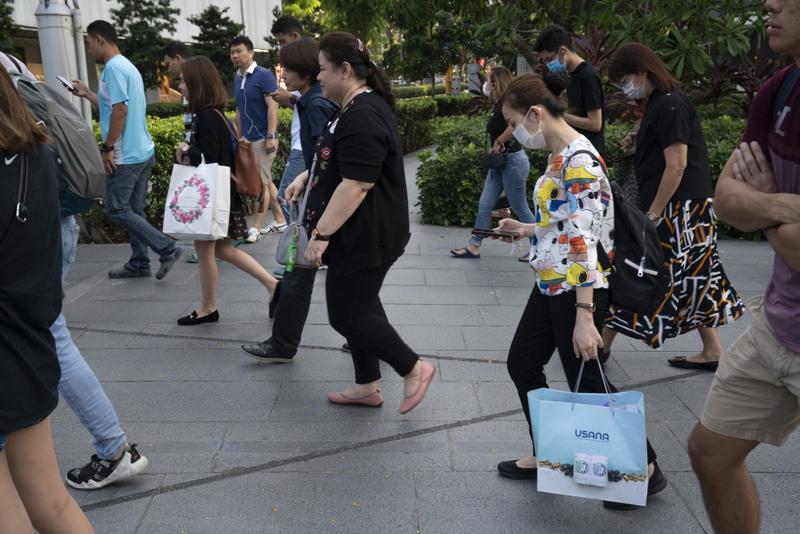 People with and without masks walk along Orchard Road in Singapore March 24, 2020. (BLOOMBERG)
People with and without masks walk along Orchard Road in Singapore March 24, 2020. (BLOOMBERG)
Even as the pandemic raced around the world in March, the Singaporean population largely seemed unperturbed. Infections ticked up steadily, before surging into a full-blown second wave on March 19. On Thursday, Singapore reported its highest ever daily tally with 287 cases; Hong Kong reported 13.
The Singapore government is calling its new lockdown measures a “circuit breaker” designed to halt transmission, but they also represented a series of U-turns
Hong Kong, which has only four COVID-19 related deaths, hasn’t seen a fatality since mid-March. Singapore has seen three deaths in April.
The Singapore government is calling its new lockdown measures a “circuit breaker” designed to halt transmission, but they also represented a series of U-turns. The government closed schools -- the education minister said Singapore was “correct” not to shut them earlier -- and planned to give every household reusable masks.
“Hong Kong closed schools much earlier, and also Hong Kong people were wearing masks very early on -- these are the two big differences,” said Jeremy Lim, an adjunct associate professor at the National University of Singapore’s Saw Swee Hock School of Public Health, who previously worked for the city-state’s health ministry.
“Singapore should have been much stronger with the social distancing requirements,” he added. “We really should have started earlier.”
‘Upper hand’
Even after the government’s change of stance, many Singaporeans appeared less cautious about spending time in crowded public areas than their Hong Kong counterparts: Last weekend, ahead of the lockdown, thousands of people thronged Ikea while restaurants were packed for one last hurrah. Since the lockdown began on Tuesday, Singapore has issued more than 10,000 warnings to rule-breakers.
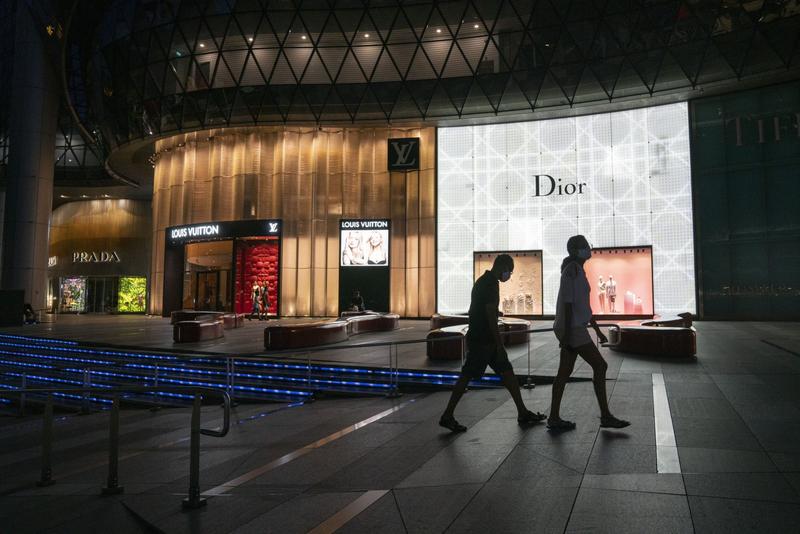 Pedestrians in a shopping district during a partial lockdown in Singapore on April 9, 2020. (BLOOMBERG)
Pedestrians in a shopping district during a partial lockdown in Singapore on April 9, 2020. (BLOOMBERG)
Singapore is also facing two additional challenges that Hong Kong may be able to avoid.
A worrying outbreak among foreign workers housed in cramped dormitories in Singapore could be a ticking time bomb, and its geographic position near sprawling Southeast Asian nations whose outbreaks are also worsening puts it at greater risk of future imported cases.
Hong Kong shares a border only with the Chinese mainland, which has wrestled its epidemic under control through strict measures, said Piotr Chlebicki, infectious disease specialist at Mount Alvernia Hospital Singapore.
“In the end, Hong Kong will probably have an upper hand,” he said. “Singapore faces a higher risk of importation and reintroduction of virus cases.”


